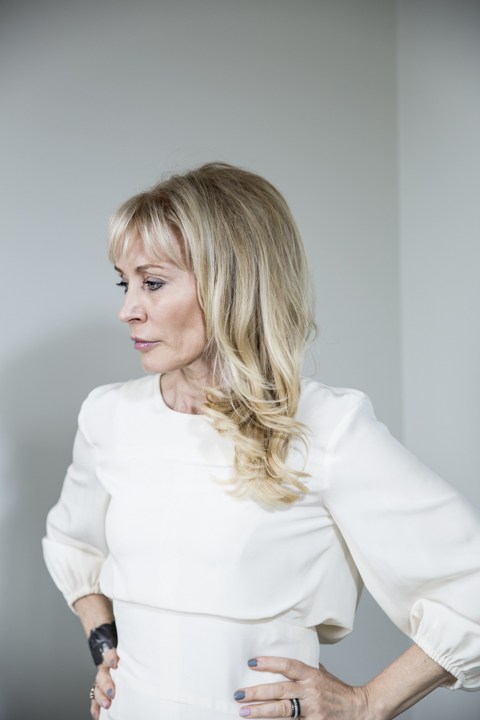
On February 5, Paula Crown’s show “THE SUBLIME AND THE CENTER: DIMENSIONS OF LANDSCAPE” will open at Marlborough Gallery. For Crown’s first solo show in New York, she is displaying both new paintings and sculptural work from her “Africa Series.” We caught up with the artist to learn about the inspiration behind the new piece, her daily studio routine, and her favorite modern artwork (hint: it’s a good one).
The Sublime and The Center: Dimensions of Landscape will be on display at Marlborough Gallery from February 5–March 7, 2015.
When did you know that you wanted to be an artist?
I do not believe there is a conscious ‘want’ to be an artist. It is something that you know instinctively. It is something you are, a part of your nature. I reflect upon my childhood and try to recall what drew my attention. What did I do before I knew that anyone was watching? I have always been an observer…a researcher…a maker.
If you weren’t an artist, what do you think you would be doing?
I would hope that it would be some activity engaging visual acuity with a sense of space and scale. For example, I am intrigued by the work of IDEO.
What are some things that inspire you?
Light, white, black, in-betweeness, connectedness, complexity, revelations of patterns in the natural order, how we come to know the world, unity, brilliant, present, committed individuals who are generous of spirit, Beethoven, Mozart and Verdi, Home Depot, my family.
Paul Crown, PERforations 2.1 (2014)
If you could own a work by any modern or contemporary artist, whom would you pick?
Guernica by Picasso. It is a transcendent painting about the devastation of war and the dark edges of human behavior. Picasso was a visual genius. He was able to see and render the world in multiple planes simultaneously to astonishing emotional effect. Picasso was living in Paris at the time of the bombing of the Basque city. He learned of it by reading the newspaper. The work is powerfully painted in the language of the media: black, white and gray. The figuration communicates unbearable pain and sadness. It is a work of tremendous insight, power, and compassion.
What can you tell us about your “Africa Series,” which comprises most of your upcoming show at Marlborough? Is it inspired by time spent in Africa?
The series is rooted in drawings made while flying in a helicopter over the Drakensberg Mountains. I was awed and humbled by their beauty and spaciousness. The marks are direct, made while moving in time and space. They were affected by the physicality of the craft, winds, and piloted direction. I was trying to connect the intimacy of that experience to the sublime expanse of the horizon. That led me to the title of the show, from the center to the sublime. We live our lives positioned from our personal center point. We look out to a horizon beyond. How do we negotiate our bearings and place in such vastness? The marks and the sketch paper edges became starting points for translation into multiple forms of two dimensional and three dimensional images and objects. These are represented in the Marlborough exhibition.
Paula Crown, Cloudy.embedded (2015)
A major theme in your work is physical vs. virtual space. How did you become interested in this notion?
Space is a medium. Gaston Bachelard wrote a beautiful book called The Poetics of Space. I love that notion. There is ‘spaciousness’ in the quantum and macro. Our virtual and physical worlds are intertwined and expand our experiences. The virtual world, however, can undermine our notions of what is real. It can be wildly distorted. To gain understanding of the interface between the physical and the conceived, it is important to inquire about any source material.
You work in multiple mediums; how do you decide which to use when?
Everything is up for grabs. Torn edges of paper, tape… I adore tape, found bits of metal, wood, or stone. I am now buying signs from people on the street. I am not sure where that is going. I also work with Adam Lowe and his brilliant team at Factum Arte. They help me translate my two-dimensional work into stone, glass, and wood objects of varying scale. I live in the art of possibility.
Paula Crown, PERforation (-) 4.54 (2015)
How do you decide what to title your works?
I am a voracious reader. I find inspiration for titles in poetry, physics, history, and dharma readings. My husband Jim has been very helpful with naming works. He came up with the “Bomber Series” and “DISoriental,” based on the carpet print paintings. I used the characteristics of quarks, (i.e. up, down, charm, strange) to name some recent paintings. It is all rather spontaneous and playful.
What does an average day in the studio look like for you?
I am at the studio at 8:30 a.m. in the morning and work without interruption from phone, email or meeting until about 1:00 p.m. It is an essential time for me to experiment, play and wander. I have reluctantly come to believe all the research that confirms multitasking is not efficient. It is a time for focus. I then have a short lunch and meditate. In the afternoon, I will attend to meetings, conference calls, fabrication details and necessary studio management details. If nothing is scheduled, I will continue to paint until approximately 7:00 p.m. so that I can make it home to have dinner with our youngest daughter and my husband.